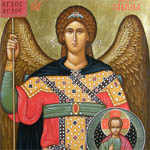Chapter Eight - Everyday Life at Court
In 1912 the entire Imperial Family went from Livadia directly to Tsarskoe Selo. Life passed tranquilly in the Tsar's house. The Emperor awoke at half past eight; at nine o'clock he took tea alone in his study. After tea he would walk in the park until ten o'clock. After ten, he would receive people, reports, etc, until luncheon which was served at one o'clock, where from time to time he would be joined by invited guests. All of the Imperial Family would gather together for luncheon (of three courses). After luncheon, the Emperor worked in his Working Study, then would join the Empress in her rooms and they would read together. After reading, the Emperor would walk with the children in the park. After this, he would receive people again until five o'clock, the hour when the entire family took tea. After tea, until dinner, each member of the family would be occupied as they pleased; the children usually prepared their lessons. Dinner was served at eight o'clock, and was composed of four courses. The Emperor only would take a small glass of wine at both luncheon and dinner. During the War, the Imperial Family's table was more sober and wine was never served at all, except for meals when they were joined by invited guests. The children only sometimes took St. Raphael wine as prescribed by their doctors.
After dinner, at about nine o'clock, they separated; the children went up to their rooms, the Emperor retired to his study for one hour to read the papers which had arrived, and then went to join the Empress, where he passed the evening with her reading and chatting until one in the morning. Often Vyroubova was there. At eleven in the evening they took tea.
. So flowed life in the Tsar's house. The Emperor never spent any part of the day away from his family other than on military holidays. If the Regiment was stationed at Petrograd, the Emperor took luncheon alone, if the Regiment was assigned to Tsarskoe Selo the Emperor would dine in the officers' mess.
The children arose at eight o'clock, took their tea and did their school work until eleven o'clock; their teachers came from Petrograd. Only Gibbs and Gilliard lived in Tsarskoe Selo. After luncheon, the children often took walks. After lucheon would be music, or hand works, such as embroidery, lace, etc.
The Empress awoke at nine o'clock and took a potion of egg yolks. Then she worked in her study, where she would receive people and hold audiences. The audiences finished, she would often ride in the park in a carriage, sometimes accompanied by her children, sometimes with one of the Ladies in Waiting (Countess Hendrikova or Baroness Buxhoeveden). After luncheon, the Empress was devoted -as we would come to say - in the Emperor's company; sometimes doing handwork or music. After tea she would do handwork or hold audiences.
The children liked to go into the Empress's rooms all of the time without being announced.
As well as the two Ladies in Waiting I have already named, there were several other persons attached to the Empress's person: Doctor E.S. Botkin and palace teacher Miss Schneider. The Tsarevich was attended by Doctor Derevenko.
The Imperial Family spent the winter and spring of 1913 at Tsarskoe Selo. The Tsarevich suffered much from hemophilia.
When the ceremonies commenced for the Tercentenary of the House of Romanov, the Imperial Family went to Moscow. There they held religious ceremonies, and receptions for both Russian and foreign delegations. They went to Moscow via Nizhny-Novogorod and the Volga, to Kostroma and the Ipatievski Monastery. There, in the center of Russia, by the same path which in olden times had been followed by Tsar Mikhail Feodorovich (the first Romanov), they returned to the Moscow area which was associated with the memories of the lives and events of the first Tsars of the Romanov Dynasty (Lake Pereyslav, the suburban Moscow villages, etc.). Through it all continued the enthusiasm of the entire population and the deputations.
After the Tercentenary celebrations, they returned to Tsarskoe Selo, and from there to the Crimea.
The Imperial Family tranquilly spent the winter of 1913-1914 at the Alexander Palace at Tsarskoe Selo.
Comments on this site should be directed to Bob Atchison.

